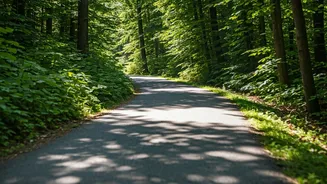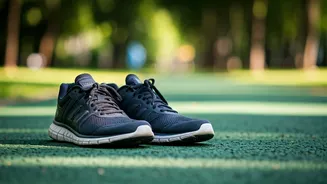Proper Walking Footwear
Selecting the right footwear is fundamental for a comfortable and safe walking experience. Opting for shoes specifically designed for walking is recommended
as they offer superior cushioning, support, and flexibility compared to standard athletic shoes. This specialized design mitigates the impact on joints and prevents injuries, particularly if you are walking on hard surfaces. It is prudent to ensure your shoes fit properly and provide adequate arch support, as this can greatly influence your posture and gait. When shopping, prioritize features like breathable materials to manage moisture and reduce the risk of blisters, alongside a snug fit that prevents your foot from sliding. Consider replacing your walking shoes every 300-500 miles, or sooner if signs of wear and tear, such as reduced cushioning or changes in sole grip, are noticeable. The right footwear is not just about comfort; it is about protecting your feet and ankles from the stresses of regular walking and enabling you to walk longer and more effectively.
Hydration is Key
Staying adequately hydrated is essential while walking, especially during warmer weather or longer walks. Dehydration can lead to fatigue, muscle cramps, and decreased performance, hindering your ability to enjoy and benefit from your walks. Carrying a reusable water bottle or hydration pack is a simple yet effective way to ensure you have easy access to water. As a general guideline, aim to drink water consistently before, during, and after your walks, adjusting the amount based on the duration and intensity of your exercise. Electrolyte-rich drinks, such as sports drinks or electrolyte tablets, can be beneficial, particularly during prolonged or strenuous walks. These drinks help to replace electrolytes lost through sweat, such as sodium, potassium, and magnesium, which are crucial for maintaining proper muscle function and preventing cramps. Listen to your body and drink when thirsty, but also proactively hydrate to avoid dehydration before you feel thirsty. Planning your route to include water fountain access or carrying your own water ensures you stay energized and perform at your best.
Protective Sun Gear
When walking outdoors, protecting your skin from the sun's harmful rays is essential. Sun exposure increases the risk of skin damage and skin cancer. Applying sunscreen with a high SPF, ideally 30 or higher, is a must-do before you start your walk. Reapply sunscreen every two hours, or more frequently if you are sweating or swimming. Along with sunscreen, wearing a wide-brimmed hat, sunglasses, and protective clothing can provide further protection from the sun. Hats shield your face, neck, and ears from direct sunlight, while sunglasses protect your eyes from UV rays. Choose clothing made from tightly woven fabrics that offer UPF (Ultraviolet Protection Factor) protection. Consider the time of day you are walking; try to avoid peak sun hours, typically between 10 AM and 4 PM. Incorporating these measures will make your walks safer, and prevent sun-related damage, allowing you to enjoy your outdoor activities while safeguarding your skin and eyes.
Wear Moisture-Wicking Clothes
Choosing clothing made from moisture-wicking materials can significantly enhance your comfort while walking, especially in warm or humid conditions. These fabrics, such as polyester or nylon blends, are designed to draw sweat away from your skin, helping you stay dry and cool. Unlike cotton, which absorbs moisture and can become heavy and clingy, moisture-wicking materials allow sweat to evaporate more quickly. This process not only keeps you comfortable but also helps prevent chafing and skin irritation. Look for clothing that offers a comfortable fit without restricting your movement. Layering your clothes can be advantageous; wear a moisture-wicking base layer to manage sweat, then add insulating layers as needed for warmth. If you are walking in cooler weather, choose breathable, wind-resistant outer layers. The right clothing can make a notable difference in your walking experience, allowing you to walk longer, feel better, and focus on enjoying your workout.
Use a Fitness Tracker
Utilizing a fitness tracker can provide valuable insights into your walking routine and help you stay motivated. These devices track metrics such as steps taken, distance covered, calories burned, and even heart rate, providing a detailed overview of your activity levels. By monitoring these metrics, you can easily track your progress and identify areas for improvement. Fitness trackers often sync with smartphone apps, enabling you to set goals, participate in challenges, and share your achievements with friends. Many devices also offer GPS tracking, mapping your routes and providing insights into your pace and elevation changes. The ability to monitor your heart rate during your walks helps you ensure you are exercising within a healthy range, making this tool a helpful companion. The data collected by a fitness tracker can motivate you to walk more, walk faster, or simply stay consistent, contributing to long-term health and well-being. Selecting a tracker with features that suit your specific needs, such as battery life, water resistance, and user-friendly interface, is crucial to making it a beneficial tool.
Carry a First-Aid Kit
Having a compact first-aid kit can be extremely helpful for addressing minor injuries or emergencies that might occur while walking. The kit should include essential items such as adhesive bandages, antiseptic wipes, pain relievers, blister treatment, and any personal medications you require. If you are prone to specific injuries, such as sprains or muscle strains, it is wise to add supportive bandages or wraps to your kit. Being prepared with a first-aid kit lets you promptly address cuts, scrapes, blisters, or other minor issues, enabling you to continue your walk safely or tend to the problem until you reach proper medical care. Consider where you typically walk and the potential hazards involved when assembling your kit; for example, if you walk in areas with insect activity, include insect repellent. Regularly check and replenish your first-aid kit, replacing any used items and ensuring that medications have not expired. The peace of mind that comes with knowing you are prepared for minor mishaps enhances your overall walking experience and allows you to enjoy your walks with confidence.
Stretching Before and After
Incorporating stretching into your walking routine is crucial for improving flexibility, preventing injuries, and maximizing the benefits of your walks. Before you start walking, perform dynamic stretches to warm up your muscles and increase blood flow, such as leg swings, arm circles, and torso twists. These movements prepare your body for exercise and help reduce the risk of injury. After your walk, engage in static stretches, holding each stretch for 15-30 seconds, to improve flexibility and cool down your muscles. Focus on stretching the major muscle groups used during walking, including your hamstrings, quads, calves, and hip flexors. Regular stretching can increase your range of motion, improve posture, and alleviate muscle soreness. It can also help reduce the risk of muscle imbalances and improve overall performance. Make stretching a regular part of your walking routine, and you will notice improvements in your mobility, flexibility, and overall well-being. It is recommended to consult a fitness professional or physical therapist for guidance on proper stretching techniques, especially if you have any pre-existing conditions.
Inform Someone of Plans
When going for a walk, particularly if you are walking alone or in an unfamiliar area, it is wise to inform someone about your plans. Let a friend, family member, or neighbor know your planned route, expected return time, and any other relevant details. This proactive measure ensures that someone knows your whereabouts and can raise the alarm if you do not return as expected. Share details such as the specific walking path, the time you plan to start, and the estimated duration of your walk. Consider carrying a charged mobile phone to make and receive calls, and ensure your emergency contact information is easily accessible. If you decide to change your route or extend your walk, remember to notify the person you informed of your original plans. This practice adds an extra layer of safety, especially if you are walking in remote or less populated areas. This habit can provide peace of mind and significantly improve your safety.












